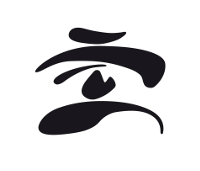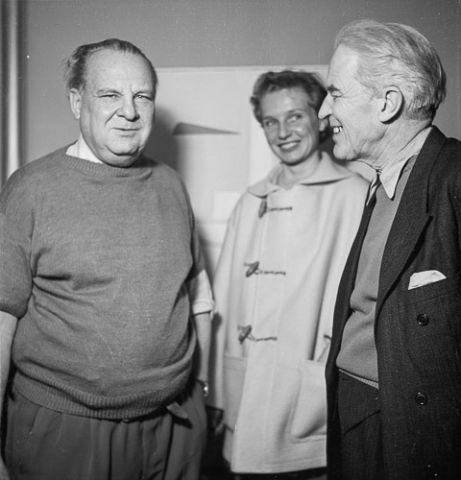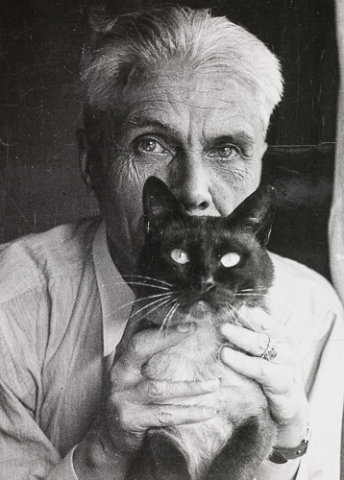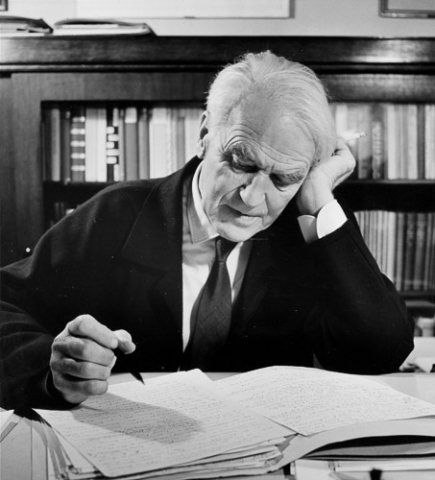Briefly presented here on a continual basis will be all those art critics, biographers, and scholars with whom Willi Baumeister was befriended, who influenced him, or in some other way crossed his path as an artist.
B Luc Bérimont | D Karl Konrad Düssel | G Will Grohmann | H Werner Haftmann | Herbert Herrmannn | Hans Hildebrandt | L Kurt Leonhard | M André Malraux | Heinrich Theodor Musper | P Erwin Petermann | R Franz Roh | S Michel Seuphor | Heinz Spielmann W Eduardo Westerdahl |
This list will be continually expanded.
Luc Bérimont
The French poet Luc Bérimont (André Leclerq) (1915 to 1964) first studied jurisprudence in Lille before beginning with his first literary works in 1938. At the outset of World War II, he initially fought in Lorraine before going underground in the French Resistance. After the war, he worked on French broadcasts for Radio Stuttgart in the capacity of a liaison officer with the American occupation forces in Germany. Bérimont was also the author of two cultural magazines for the news service: Die Quelle (The Source; in German) and Verger (in French). For one issue of Verger (1947), Baumeister wrote the article Remarques sur les rapports du théatre et de la peinture. Bérimont visited Baumeister several times from Baden-Baden and wanted to organize a Baumeister exhibition in Paris. Moreover, it was his wish that Baumeister illustrate one of his epic poems. Seven drawings to Avant la première journée du monde thus emerged. From 1948 on, Bérimont worked for French radio. Besides poems, his literary oeuvre also includes novels.
Karl Konrad Düssel
The German art critic and publicist Karl Konrad Düssel (1872 to 1940) studied medicine and philosophy before switching to journalism. First a critic at the Bonner Generalanzeiger, in 1926 he went to the Stuttgarter Neues Tagblatt, then briefly to the Deutsche Allgemeine Zeitung in Berlin. He became known for his sure judgment and gave the Tagblatt's cultural-political section its special character. Due to political conditions, he left the editorial staff prematurely in 1935. He made contact with Adolf Hölzel right at the beginning of his Stuttgart period. He garnered great interest for Baumeister and Schlemmer and wrote positively about their works. In the 1930s, Düssel and Baumeister played chess weekly. Düssel wrote several times about Baumeister. In the article from November 8, 1927, Willy Baumeister nach Frankfurt berufen (Willy Baumeister called to Frankfurt) he reproached the Stuttgart Academy for its neglect. On September 23, 1940 Willi Baumeister wrote in his diary about Düssel: He is of consistent mind when it comes to modern painting. At an advanced age, he judges unusually, [in a manner that is] strongly active and young.
Will Grohmann
The art historian and art critic Will Grohmann (1887 to 1968) wrote monographs about Kirchner and Kandinsky in the 1920s. In journals he wrote about Klee, Schlemmer, and Baumeister. Grohmann was a friend of and spokesman for the avant-garde and in 1948 became professor of art history at the College for the Fine Arts in Berlin. Literature about Baumeister (selection): monograph in the Peintres Nouveaux series, Paris 1931; W.B., Stuttgart 1952; W.B. - Leben und Werk , Cologne 1963 (English translation: New York 1965; French translation: Brussels 1966). In 1954 Grohmann wrote the text for Ottomar Domnick's film about Willi Baumeister.
Werner Haftmann
The German art historian and archaeologist Haftmann (1912 to 1999) was a lecturer at the Hamburg College for the Fine Arts beginning in 1950, and in 1954 published a standard work on painting in the 20th century. In 1955, 1959, and 1964 he was responsible for the art historical supervision of documenta I, II, and III. From 1967 to 1974 he was the first director of the Neue Nationalgalerie in Berlin. Wrote important publications: Deutsche Maler der Gegenwart (Contemporary German Painters, 1949), Paul Klee (1950), Malerei im 20. Jahrhundert (Painting in the 20th Century, 1954-55), Emil Nolde (1958), Verfemte Kunst (Banned Art, 1986). With Willi Baumeister and others, he was a jury member for the 1949 Munich exhibition, Kunstschaffen in Deutschland (Art Production in Germany), organized by the American military government. He also edited a publication of the Haftmann/Baumeister correspondence on documenta I (1955). Publications about Baumeister (selection): W.B., Exhib. cat. Wuppertal 1959; W.B. - Ernst Wilhelm Nay, Kunsthalle Basel 1960; W.B. Zeichnungen und Gouachen (Drawings and Gouaches), Berlin Nationalgalerie 1972; W.B. Gilgamesch, Cologne 1976; W.B. Saul, St. Gallen 1976.
Herbert Herrmann
The German art historian Herbert Herrmann (1906 to 1966) studied art history, Egyptology, and archaeology in Munich and Berlin and earned a doctorate with the dissertation, Untersuchungen über Landschaftsgemälde des Peter Paul Rubens (Research on the Landscape Painting of Peter Paul Rubens). He first met Willi Baumeister in August 1936, which developed into a close, year-long friendship in which the family was also included. Herbert Herrmann helped Baumeister with the organization of the photographic index of his pictures, among other things. In 1940 Herbert Herrmann received an appointment in the Dr. Kurt Herberts varnish vactory in Wuppertal, where Baumeister was also employed, to set up a varnish museum from Kurt Herberts's collection objects. The appointment in Wuppertal ended with his military conscription in May 1941. Herrmann had contacts with many artists, publicists, and galleries. With a Wehrmacht -owned projector, Hermann showed slides of Baumeister's pictures to art enthusiasts. At the end of World War II Baumeister gave him 44 drawings after text passages from Saul out of the Old Testament to show art enthusiasts in Paris. Georges Braque spoke very positively about the drawings. From Paris Herrmann brought greetings and great recognition from all sides. In 1946 - following Herbert Herrmann's return from American captivity - Willi Baumeister engaged him as a reader for the book project Das Unbekannte in the Kunst (The Unknown in Art). In 1947 Herrmann opened a gallery in Stuttgart that chiefly exhibited modern art. The gallery's colophon was the motif of the runner from Willi Baumeister. The second exhibition showed pictures by Baumeister. The gallery closed in January 1949. Herrmann owned numerous works by Willi Baumeister. From 1953 to 1955 he worked as an official in the Lower Saxony Cultural Ministry. - Literature: Rudolf Mayer: Der Läufer (The Runner). Die Galerie Herbert Herrmann Stuttgart 1947-1948. Stuttgart 1954.
Hans Hildebrandt
Around 1910 the German art historian Prof. Dr. Hans Hildebrandt (1878 to 1957) began his engagement with modern art and later became a professor at the Stuttgart Technical College. During the Nazi period he worked with Baumeister in the Dr. Kurt Herberts varnish factory in Wuppertal on the publication Wände und Wandbild (Walls and Wall Picture, pub. 1953). His most important publications in connection with Willi Baumeister include: Handbuch der Kunstwissenschaft (Handbook of Art Scholarship, 1931), Adolf Hölzel and sein Kreis (Adolf Hölzel and His Circle, 1936 in Swizterland), L'Art dans l'Allemagne d'aujourd'hui (Art in Germany Today, 1949), an essay in Die schöpferischen Kräfte in der abstrakten Malerei (The Creative Forces in Abstract Painting, 1947), a contribution to the New York exh. cat. Willi Baumeister (1952), Willi Baumeister zum Gedächtnis (In Memory of Willi Baumeister, 1955).
Kurt Leonhard
The German art scholar, translator, and poet Kurt Leonhard (1910 to 2005) was active during the National Socialist regime in the book and art trade in Berlin, as the successor to émigré Curt Valentin. Leonhard was very influential as an art critic in the postwar period. After the war and American captivity, he ended up in Esslingen and represented the position of artists working in a nonrepresentational mode, such as Ida Kerkovius, HAP Grieshaber, Willi Baumeister, and Julius Bissier. His important publications include: Die heilige Fläche (The Holy Surface, 1947), Augenschein und Inbegriff (Appearance and Incarnation, 1953), Wort wider Wort (Word Against Word, 1973). In Die heilige Fläche - Gespräche über moderne Kunst the painter not referred to by name - according to information from Kurt Leonhard - has to do with Baumeister, from whom a few paintings are also reproduced in the book.
André Malraux
The French writer and politician André Malraux (1901-1976) began early on to be concerned with new art, and also worked for the art dealer Daniel-Henry Kahnweiler. Already in 1920, he published articles on modern literature and art. In 1933 he appeared as a speaker at the Association des Ecrivains et Artistes Révolutionaires (Association of Revolutionary Writers and Artists) organized by André Gide. He met Leon Trotzky. In 1934, he participated in the first Soviet writer's congress in Moscow and met Stalin. In 1935 he organized with André Gide the Congrès international des écrivains pour la défense de la Culture (International Congress of Writers for the Defense of Culture). Beginning in the summer of 1936, Malraux actively engaged in the Spanish Civil War. In August 1945, he met Charles de Gaulle. Malraux was minister of information until 1946, then became director of the news service, after which he was appointed minister of culture. He produced the books on art, La Psychologie de l'Art (The Psychology of Art, 1947-49) and Musée imaginaire (Imaginary Museum, 1953-55). For the 14th of July 1947 he wrote the article Der Mensch und die künstlerische Kultur (The Human and Artistic Culture) in Zurich. In Das Kunstwerk of 1946-1947, Baumeister responded to Malraux in an open letter: The content of your article moves me because in it prevails a great correspondence with a book that I wrote in 1943 [Das Unbekannte in der Kunst], when circumstances forced me to no longer even paint behind locked doors. ... You write:"The power of the West consists in the willing recognition of the unknown," and: "Europe has stressed above all the opinion that the great artist lives from discoveries, and that his discoveries are irrational and thus not to be predicted." I write in my book: during artistic activity, the artist deviates imperceptibly from his preconceived goal ... only thereby does he land with his finished work in the unknown. ... Since the unknown is completely unknown, it cannot be aimed at as a goal, although a goal is present at the outset of every type of work. This preconceived goal reveals itself, in hindsight, to be a stimulus and imaginary goal. The great discoveries and inventions are not found in the preconceived goal. In 1966, in his capacity as French Minister of Culture, Malraux hosted the reception of the large retrospective of Baumeister pictures in the Musée National d'Art Modern in Paris.
Heinrich Theodor Musper
The German art historian Dr. Heinrich Theodor Musper (1895 to 1976) was Director of the Staatsgalerie Stuttgart from 1948 to 1963. Beginning in 1933 he cultivated an acquaintance with Baumeister. They met often, especially during the wartime. In 1944 Musper and Baumeister together with Karl Gutbrod held discussions about art that led to the writing of the text, Das Unbekannte in der Kunst (The Unknown in Art). Directly after the currency reform, Musper facilitated a lively exhibition activity. During Baumeister's stay at Lake Constance in autumn 1945, Musper and Erwin Petermann campaigned for his candidacy as director of the State Academy of Art in Stuttgart. Baumeister ultimately received a post as professor for painting at this academy in 1946. In 1954 Musper wrote the article Willi Baumeister als Illustrator (Willi Baumeister as Illustrator) for the newspaper Stuttgarter Leben.
Erwin Petermann
The great German graphic connoisseur Erwin Petermann (1904 to 1989) was Director of the Staatsgalerie Stuttgart from 1963 to 1969. In autumn 1945 he and Heinrich Theodor Musper campaigned for Baumeister's candidacy as director of the State Academy of Art in Stuttgart. In 1946 Baumeister received a position as professor for free painting at this academy. Petermann played a decisive role in realizing valuable donations to the Staatsgalerie Stuttgart's graphic collection, such as the European graphic prints of collector Max Kade.
Franz Roh
In 1920 the German art critic, photographer, and artist Franz Roh (1890 to 1965) earned a doctoral degree under Heinrich Wölfflin and at this time first exhibited his own photocollages. He wrote critiques for the journals Cicerone and Kunstblatt, and after the war for the US-American Neue Zeitung published in Munich. This work brought him into close contact with contemporary artists, including Willi Baumeister. Roh was known as a great spokesman and supporter of abstract art in Germany after 1945 and published numerous books and essays on German contemporary art. In 1949 he was the art historical consultant to the group ZEN 49. In 1950 he participated in the First Darmstadt Dialogue (Erstes Darmstädter Gespräch).
Michel Seuphor
Beginning in 1924, Baumeister met the Belgian art critic, painter, graphic artist, and ceramicist Michel Seuphor (1901 to 1999) often in the circle around Le Corbusier, Léger, Piet Mondrian, and Hans Arp in Paris. Seuphor wrote about Baumeister several times. As an artist, he was a representative of abstraction.
Heinz Spielmann
The German architect and art critic Heinz Spielmann (born 1930) wrote a doctoral dissertation about Andrea Palladio and later took a position at the Museum for Art and Industry in Hamburg. In 1984 he became professor for 19th and 20th-century art at Munster University. From 1986 to 1998 he was Director of the Schleswig-Holstein Landesmuseum Schloss Gottorf, and afterward artistic consultant to the Bucerius-Kunstforum in Hamburg until 2005. The first meeting with Baumeister took place in 1950 during his architectural studies, which partly took place in the rooms of the Stuttgart Art Academy. Spielmann offered Baumeister a lecture on modern art in connection with the general studies. Spielmann curated several exhibitions of Baumeister's work, including Gilgamesh in Hamburg 1964, Figur und Abstraktion (Figure and Abstraction) at Schloss Gottorf 1993, and for the 50th anniversary of the artist's death W.B. - Figuren and Zeichen (Figures and Signs) in Hamburg, Munster, and Wuppertal 2005. He has written diverse essays about Baumeister and the catalogue raisonné of the graphic works: 1963 Die Serigraphien (The Serigraphs), 1965 Die Lithographien, Radierungen, Originalgraphischen Plakate (The Lithographs, Etchings, Original Graphic Posters), 1966 Katalog der typographischen Arbeiten (Catalogue of the Typographical Works), 1972 special publication Das Graphische Werk (The Graphic Work), 2005 Werkkatalog der Druckgraphik (Catalogue Raisonné of the Graphic Works, with Felicitas Baumeister).
Eduardo Westerdahl
The Spanish painter and art critic Westerdahl (1902 to 1983) founded the international art journal Gaceta de Arte in 1932. The friendship with Baumeister began at this time, about which he wrote one of the earliest biographies in 1934. Initially the connection only existed through letters. The first meeting took place in 1950 at the Second International Art Congress in Spain's Santillana del Mar.



